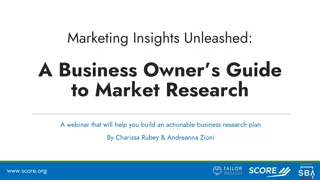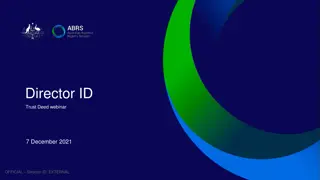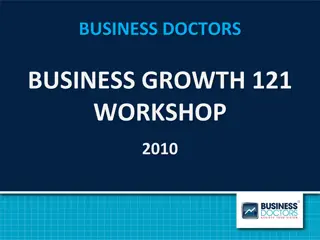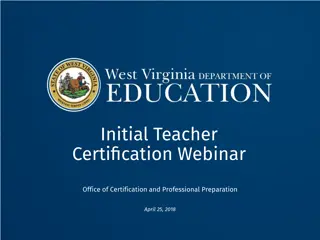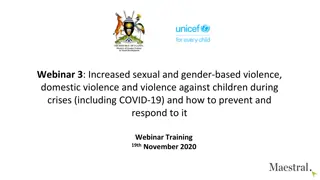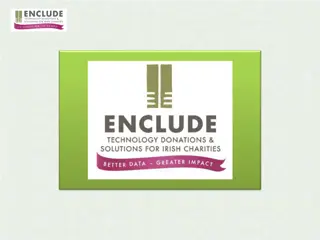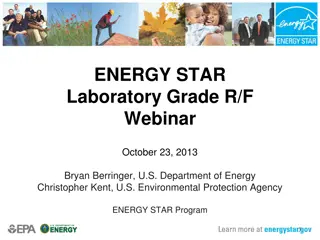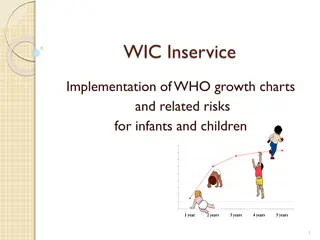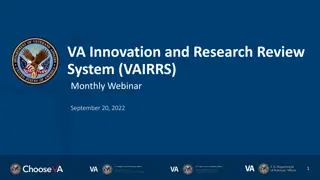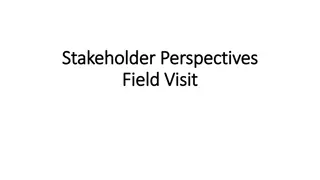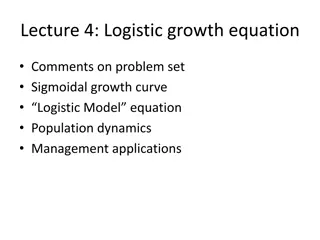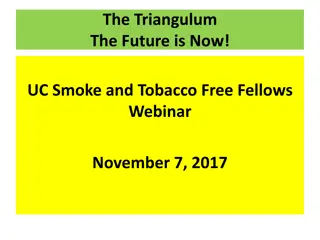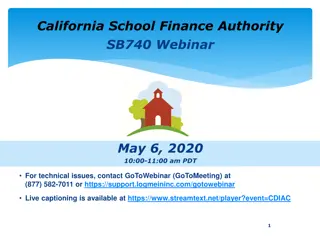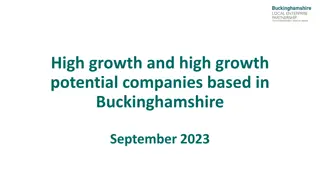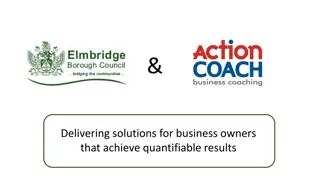Webinar on Business Landscape Analysis and Growth Strategies
Explore opportunity identification, feasibility assessment, business planning, fundraising, phased development, and growth strategies in this comprehensive webinar led by Kathy Nyquist. Understand how to define your unique market position, attract investors, and communicate effectively with customers. Gain insights into industry analysis, competitive landscape, and strategic planning to enhance your business success.
Download Presentation

Please find below an Image/Link to download the presentation.
The content on the website is provided AS IS for your information and personal use only. It may not be sold, licensed, or shared on other websites without obtaining consent from the author.If you encounter any issues during the download, it is possible that the publisher has removed the file from their server.
You are allowed to download the files provided on this website for personal or commercial use, subject to the condition that they are used lawfully. All files are the property of their respective owners.
The content on the website is provided AS IS for your information and personal use only. It may not be sold, licensed, or shared on other websites without obtaining consent from the author.
E N D
Presentation Transcript
The Business Landscape Session One October 9, 2013 Kathy Nyquist Principal, New Venture Advisors LLC Chicago, IL (773) 245-3570 newventureadvisors.net
1 Opportunity Identification Environmental Assessment 3
2 Feasibility Assessment Shape Concept Test Viability Environmental Assessment 4
3 Business Planning Strategic Plans Pro Forma Environmental Assessment Shape Concept Test Viability 5
4 Fundraising Financing Plan Investor Pitch Strategic Plans Pro Forma Environmental Assessment Shape Concept Test Viability 6
5 Launch Phased Development Lean Startup Strategic Plans Pro Forma Environmental Assessment Shape Concept Test Viability Financing Plan Investor Pitch 7
6 Stabilize and Grow Finance, Marketing, Operations Growth Strategy Strategic Plans Pro Forma Environmental Assessment Shape Concept Test Viability Financing Plan Investor Pitch Phased Development Lean Startup 8
Background 1=strongly disagree 4=strongly agree Survey questions informing this Section Able to clearly state our mission to attract investors and clients 2.9 Know our solution is the right one and how it is differentiated 3.3 Have a strong business model 2.6 Have a clear understanding of and plan for our business offerings 3.0 Able to define our market, its potential size, future customers 2.9 Undertaken a thorough industry / sector analysis 2.5 Understand our competition 2.8 Understand our competitive advantages and disadvantages 2.9 9
Objective To clearly define your unique position in the market For listeners in assessment mode you will design a better business For listeners in operations mode you will strengthen your understanding of the market in which you compete and how to communicate with customers 10
Agenda Webinar 1 will help you: Webinar 2 will help you: Define the industry and market size, structure, trends Define who you are mission, business model, value proposition Understand the field competitive landscape Define the customer segmentation, target market selection Know why you will win differentiation, barriers Develop your brand brand foundations 11
Part 1 DEFINE WHO YOU ARE 12
Define Who You Are Define Who You Are Mission Business Model Customer Segmentation Target Market Selection Customer Benefits Value Proposition 13
Define Who You Are What s the connection? SOLVING PROBLEMS Missions solve pressing problems Great businesses solve big problems Investors want to know How big is the problem? How unique is your solution? 14
Define Who You Are Business Model Products & Services what it is fruit & veg, protein, value-added what it does Products & services To which customers How delivered Revenue model Fruit & veg Protein Value-added Dry goods 15
Define Who You Are Business Model How Delivered Go to market strategy Brick & mortar vs. virtual/online Distribution Joint ventures, strategic partnerships Products & services To which customers How delivered Revenue model Fruit & veg Protein Value-added Dry goods Go-to-market strategy Brick & mortar Virtual/online Distribution JV/Partnerships 16
Define Who You Are Business Model To Which Customers Wholesale Retail Target market selection Products & services To which customers customers To which How delivered Revenue model Fruit & veg Protein Value-added Dry goods Go-to-market strategy Brick & mortar Virtual/online Distribution JV/Partnerships Wholesale Retail Target market selection 17
Define Who You Are Business Model Revenue Model How you make money Commission/brokerage fee vs. buy/sell Subscription/monthly recurring revenue Pricing strategy Products & services To which customers How delivered Revenue model Fruit & veg Protein Value-added Dry goods Go-to-market strategy Brick & mortar Virtual/online Distribution JV/Partnerships Wholesale Retail Target market selection Buy/sell Commission Brokerage fee Subscription Pricing strategy 18
Define Who You Are Business Model How are you differentiated? Products & services To which customers How delivered Revenue model Fruit & veg Protein Value-added Dry goods Go-to-market strategy Brick & mortar Virtual/online Distribution JV/Partnerships Wholesale Retail Target market selection Buy/sell Commission Brokerage fee Subscription Pricing strategy 19
Define Who You Are Segmenting the Market Defining a group of potential customers whose problem or use of your solution share several characteristics Custom characteristics Standard characteristics Industrial classification Geographic regions or sales territories Basic demographic groups Purchase or usage groups Values or lifestyle classifications Product attribute preferences Benefits sought Brand preferences/ loyalty Price sensitivity Socioeconomic status Deal proneness 20
Define Who You Are Segmenting the Market Product what you sell Commodity types Fresh vs. value-added Customer to whom Consumer, Chef Who s the Buyer? Distributor, Mgt co Geography where Primary markets Entire trading area Along existing routes Channel how reached Retail direct Wholesale through intermediaries 21
Define Who You Are Selecting a Target Market In which you are differentiated In which you can deliver value quickly In which customers are accessible Path to cash flow positive In which there are adjacent markets for growth 22
Define Who You Are Segmentation, Target Farmers Market, CSA Restaurant & Grocery Chains Specialty Grocery Chefs Price Specialty Distributors Broadline Distributors Volume 23
Define Who You Are Benefit Ladder Emotional Benefits How customers feel about your product/service Makes me happy Consumer Benefits Tastes good and refreshing Customer advantage based on functional benefits Product Benefits Sweet effervescent beverage Functional benefits provided by product attributes Product Attributes Brown carbonated sugar water Features and attributes of the product/service offering 24
Define Who You Are Benefit Ladder Consumer Emotional Benefits How customers feel about your product/service Peace of mind Consumer Benefits Safe for me and my family Customer advantage based on functional benefits Product Benefits Functional benefits provided by product attributes Sustainably produced Product Attributes No chemical pesticides or GMOs Features and attributes of the product/service offering 25
Define Who You Are Benefit Ladder Customer Emotional Benefits How customers feel about your product/service More successful Consumer Benefits Customer advantage based on functional benefits Save me time Product Benefits Easy access to quantity, quality Functional benefits provided by product attributes Product Attributes Features and attributes of the product/service offering Aggregated local produce 26
Define Who You Are Value Proposition Customer Problem Situation which puts them in your market Cannot access high volumes of quality local produce without serious effort Relevant Solution Product/service offering what it is, what it does features & attributes compelling reason to buy Aggregate fresh produce from local farms, packed to your specifications Specific Benefits Quantified value Get what you need through one point of contact - variety, quantity, quality 27
Define Who You Are Value Proposition You must talk to customers at least 25 Highest order communication make it plain and understandable to customer Remember Great businesses solve big problems Investors want to know How big is the problem? How unique is your solution? 28
Define Who You Are Summary Mission Business Model Customer Segmentation Target Market Selection Customer Benefits Value Proposition Next Next 29
The Business Landscape Session Two October 11, 2013 Kathy Nyquist Principal, New Venture Advisors LLC Chicago, IL (773) 245-3570 newventureadvisors.net
Objective To clearly define your unique position in the market For listeners in assessment mode you will design a better business For listeners in operations mode you will strengthen your understanding of the market in which you compete and how to communicate with customers 33
Agenda Webinar 1 will help you: Webinar 2 will help you: Define the industry and market size, structure, trends Define who you are mission, business model, value proposition Understand the field competitive landscape Define the customer segmentation, target market selection Know why you will win differentiation, barriers Develop your brand brand foundations 34
Part 2 DEFINE THE INDUSTRY 35
Industry Analysis Industry Analysis Market structure Top-down market sizing Growth rate, sales projections Nature of participants Ratios Key success factors Trends Long-term prospects 36
Industry Analysis Market Structure Grocery Industry definition Sector Dairy Industry Consider buyer s range of authority Frozen Category Buyer Ice Cream Segment Sub- Segment Premium And consumer s frame of reference Novelties Product Consumer Dove Brand Toffee SKU 37
Industry Analysis Buyer s Range of Authority Groceries in Canada $X Billion Wholesale Fresh Produce $X Million Dry Goods $X Million Dairy $X Million Meat $X Million Frozen $X Million Dairy $X Million Frozen $X Million Dinners $X Million Fluid F&V $X Million $X Million 38
Industry Analysis Consumer s Frame of Reference Breakfast Foods $X Billion Breakfast Foods $X Billion Scratch $X Million Bars Toaster $X Million $X Million Convenient $X Million Cereal $X Million Bars Trail Mix $X Million $X Million Cereal $X Million 39
Industry Analysis Sizing the Market Top-Down Product made with nuts, fruit and granola like a Breakfast Bar but in a pouch with loose ingredients like Trail Mix Category Breakfast Foods $34B Healthy Snacking $29B Segment Breakfast Bars* $743M Nuts/Seeds $1.8B Segment Breakfast Trail Mix new! Granola Bars $910M Segment Trail Mix $277M *Also includes Cereal/Snack Bars Category Definition Frame of Reference Source of Volume Industry Size Breakfast Foods + Healthy Snacking = $63B Breakfast Trail Mix Segment = $?M Convenient Breakfast Foods Breakfast Bars + Granola Bars = $1.7B 40
Industry Analysis Frame of Reference From consumer s point of view Establishes your competitive set Informs your comparative communication Large enough to capture meaningful volume Small enough to be differentiated 41
Industry Analysis Sizing the Market Top-Down Product made with nuts, fruit and granola like a Breakfast Bar but in a pouch with loose ingredients like Trail Mix Category Breakfast Foods $34B Healthy Snacking $29B Segment Breakfast Bars* $743M Nuts/Seeds $1.8B Segment Breakfast Trail Mix new! Granola Bars $910M Segment Trail Mix $277M *Also includes Cereal/Snack Bars Category Definition Frame of Reference Source of Volume Industry Size Breakfast Foods + Healthy Snacking = $63B Breakfast Trail Mix Segment = $?M Convenient Breakfast Breakfast -or- Healthy OTG Breakfast? Convenient Breakfast Bars + Granola Bars = $1.7B SOV > Category 42
Industry Analysis Growth Rate, Projections From industry analyst reports 43
Industry Analysis Nature of Participants Post- Harvest Retail Sales Outlets Production Distribution GROCERY Stores Home Delivery Growers and Producers MERCHANT WHOLESALERS Specialty Produce Broad Line Importers Specialty Produce FOODSERVICE Contract Catering Restaurants Grower - Shippers Aggregators Self-Distributing Retailers DIRECT Farmers Markets Farm Stands CSAs Processors Brokers, Agents, Auctions, Exchanges Exchanges 44
Industry Analysis Key Ratios P&L Pro Forma Volume (Cases) Average Price/Case Sales Returns Net Revenue Cost of Goods Sold (COGS) Gross Margin Sales, General and Administrative Depreciation & Amortization Operating Margin Financing Expense Taxable Income Tax @ 35% Net Income/Profit Margin Annual 312,500 $24.00 $7,500,000 ($150,000) $7,350,000 ($5,808,193) $1,541,807 ($1,081,300) ($23,093) $437,414 ($19,200) $418,214 ($146,375) $271,839 % Sales Sysco Industry 2% 21% 14% 18% 13% 11% 10% 6% 5% 1% 4% 2.5% <1% Cash from Operations $286,633 Others: sales/sq ft, inventory turnover, velocity, rev/employee 45
Industry Analysis Finally Key Success Factors Long Term Prospects Trends Product innovation Service levels Operating efficiency Supply chain relationships Industry Consumer Political Economic Likely time horizon for trends Opportunity for enduring success 46
Industry Analysis Summary Market structure Top-down market sizing Growth rate, sales projections Nature of participants Ratios Key success factors Trends Long-term prospects 47
Part 3 UNDERSTAND THE FIELD 48
Local Market Local Market Analysis Bottom-up market sizing Competitive landscape Differentiation 49
Local Market Start Up Financial Forecast $2,000 $1,500 Thousands $1,000 $500 $0 -$500 Year 1 $100 $200 -$100 Year 2 $200 $300 -$100 Year 3 $400 $400 $0 Year 4 $800 $780 $20 Year 5 $1,600 $1,520 $80 Revenue Expenses EBITDA % Growth 200% 200% 200% 200% 200% % Margin -100% -50% 0% 2.5% 5.0% 50




